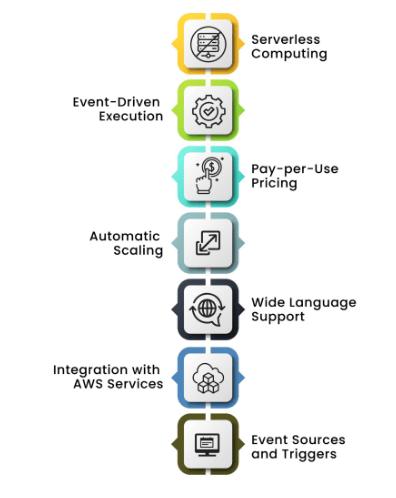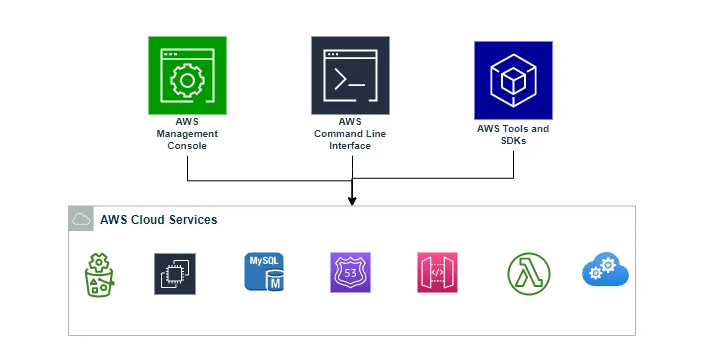
- Introduction to AWS Management Console
- Key Features of AWS Management Console
- How AWS Management Console Works
- Benefits of AWS Management Console
- Navigation and Interface of AWS Management Console
- Security Features of AWS Management Console
- AWS Management Console for Beginners
- Conclusion
Introduction to AWS Management Console
The AWS Management Console is a web-based graphical user interface (GUI) that allows users to access, manage, and monitor their AWS services and cloud resources efficiently. Designed to support users of all technical backgrounds, the console provides a centralized platform where you can easily navigate and interact with various AWS services, including Amazon EC2, S3, RDS, Lambda, CloudWatch, and more. Launched by Amazon Web Services, the console simplifies the process of provisioning, configuring, and overseeing infrastructure in the cloud, as covered in Amazon Web Services Training. It features an intuitive dashboard, service search functionality, and guided workflows that help streamline tasks such as launching instances, setting up storage, and configuring databases. The AWS Management Console also integrates with identity and access management (IAM), enabling users to control permissions and maintain secure access to resources. Whether you’re a developer deploying applications, an IT administrator managing infrastructure, or a business professional exploring cloud services, the AWS Management Console offers a user-friendly environment to operate and optimize your AWS ecosystem. With real-time metrics, billing information, and easy-to-use management tools, the console is an essential resource for efficiently managing cloud operations.
To Explore AWS in Depth, Check Out Our Comprehensive AWS Course To Gain Insights From Our Experts!
Key Features of AWS Management Console
The AWS Management Console is equipped with several powerful features that enhance usability and make managing AWS services simpler:
- Unified Dashboard: The console offers a customizable dashboard where users can view a summary of their AWS services, recent activity, and resource usage.
- Service Catalog: AWS services are organized in an easy-to-navigate catalog, enabling users to quickly locate and access the services they need to manage their infrastructure.
- Resource Management: The console provides graphical and tabular views of all your account’s resources, enabling you to efficiently manage EC2 instances, S3 buckets, IAM roles, and more, while integrating with AWS EventBridge to automate event-driven workflows.
- Real-Time Monitoring: The console integrates with Amazon CloudWatch, giving users real-time insights into the performance of their resources, such as EC2 instance health, Lambda functions, and more.
- Multi-Region Support: The console allows users to manage resources across multiple AWS regions, allowing them to set up, monitor, and maintain infrastructure globally.
- Interactive Wizards: The console includes step-by-step wizards for configuring services like EC2 instances or creating S3 buckets, simplifying the setup process.
- Real-Time Monitoring: Integration with Amazon CloudWatch provides a real-time view of your AWS resources’ performance. This is essential for troubleshooting, identifying performance bottlenecks, and making adjustments.
- Security and Permissions: AWS integrates the console with IAM (Identity and Access Management), allowing administrators to set granular access controls and manage who can access specific AWS resources.
- Ease of Use: The console is designed to be user-friendly, with a clean and simple interface that helps new users quickly understand how to manage their AWS resources. It includes wizards, helpful tips, and step-by-step guides for various tasks.
- Time-Saving: With the AWS Management Console, users can easily configure and monitor services without interacting with a command-line interface, similar to the ease of management offered when Exploring Azure Service Fabric. This graphical interface saves time and eliminates the need for manual processes.
- Comprehensive Access: The console provides full access to all AWS services. Whether you’re managing compute resources, databases, storage, or network configurations, the console provides comprehensive tools for managing your AWS environment.
- Cost Management: The AWS Billing and Cost Management Dashboard, integrated with the console, allows you to view and analyze your AWS costs and usage. It provides insights into your AWS spending and allows you to set budgets and alerts to avoid unexpected charges.

How AWS Management Console Works
The AWS Management Console is a browser-based interface designed for ease of use, allowing users to access and manage AWS services efficiently. Sign-in is the first step, requiring users to log in with their AWS credentials, which directs them to the console homepage, where all AWS services are accessible. Navigating Services is simplified through a left-hand navigation pane that categorizes services into Compute, Storage, and Networking sections. Once logged in, users can select a service and proceed with Service Configuration, such as launching virtual machines in EC2 or managing storage buckets in S3, with intuitive options available for each service, while also leveraging AWS Secrets Manager for Secure Data to manage sensitive information securely. The console also provides Access to Features like monitoring, security management, billing, and reporting, which can be accessed through respective service interfaces or the centralized “Management Console” dashboard. Additionally, Multi-Account Access is supported via AWS Organizations, enabling seamless resource management across multiple AWS accounts under a single login.
Interested in Obtaining Your AWS Certificate? View The AWS Course Offered By ACTE Right Now!
Benefits of AWS Management Console
The AWS Management Console provides several benefits that help users manage their AWS environment effectively:





